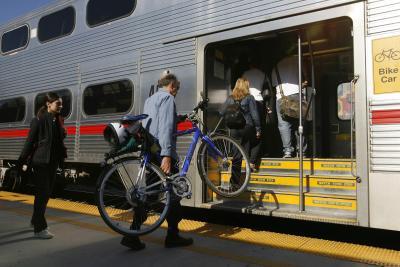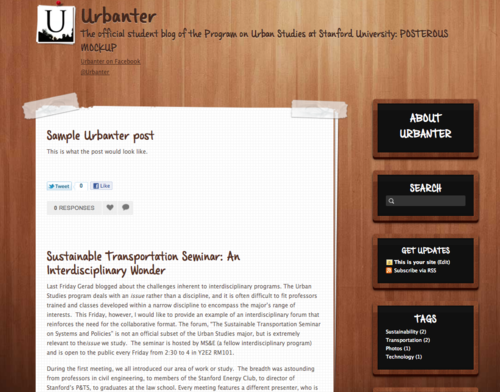Earlier today I met with George Carollo, a senior in Urban Studies with a self-designed concentration in Urban Design and Architecture. We talked about his recently completed honors thesis, which he will be presenting at the Urban Studies Honors Thesis Colloquium on Thursday, June 2nd. Thanks for taking the time to share your experiences with Urbanter, George!
Urbanter: What is the topic of your research?
George: I looked at what motivates people to cycle in conjunction with mass transit. Specifically trains, and even more specifically, the Caltrain and BART. I wanted to know which factors were most important in determining whether someone brings his or her bike along on the train. The variables were grouped in three categories: commute facts (such as distance), demographics (such as gender), and attitudes/preferences (such as environmental consciousness). I conducted about 600 surveys on the trains and 7 in-depth interviews to try an find patterns among these variables.
U: What led you to choose this topic?
G: Personal experience both with riding the trains in the Bay Area and cycling for recreation lead me to this question. I’ve taken the train plenty of times, but I began wondering why I didn’t take my bike on the train. Biking after getting off the train seems like a pretty hassle-free option for getting to one’s final destination, but it is not the norm—why not?
U: Describe of the week before it was due in one word?
G: Costly. By the final week I was done with my paper and only had nitpicky editing to do with commas, missing letters and spelling errors. I was at the point where I couldn’t catch them myself because I had read the paper too many times so instead I offered the freshman in my dorm ¢25 for every error 😀.
U: What part of the process was most rewarding?
G: I used both qualitative and quantitative data and I had a high point with each. For the qualitative data, collecting it was the most rewarding part. It was great to connect with the cyclists on the trains over this common interest. For the quantitative data, is was really rewarding, as well as a relief, when my number crunching was done. When I first put the stack of surveys on my desk and began data entry, all I could think was “I hope this turns into some sort of valuable statistics.” Thankfully the regressions did turn out some interesting numbers and it really was rewarding to see those results after all the time I’d put in.
U: What was the biggest surprise you encountered in doing your research?
G: I was surprised by how smoothly the train surveys went and how willing people were to help me out. I was only turned down about 15 percent of the time and in general, people were really friendly. It might have had something to do with the fact that the respondents were stuck in the train cars—they couldn’t exactly escape me—but even still, I was pleasantly surprised.
U: What advice do you have for others planning on doing capstone research?
G: First, narrow the focus of your question as much as possible. I did narrow my topic by location, but I learned that there might have been other methods for narrowing—like focusing on the effect of distance rather than considering multiple variables. On a different note: take as many research and skills classes as possible, and take them as early as possible. Also maybe take more than your think you need. If I’d had GIS skills before taking Preparation for Honors Thesis in junior year I definitely would have incorporated mapping into my research.
U: What are your plans for next year?
G: I will be co-terming next year in Civil Engineering’s “Sustainable Design and Construction” program. I’m hoping it will give me a better sense of the field I want to enter after Stanford. Also, this summer I will be working with a national transportation, planning, and engineering firm so that I can expand on what I learned through my honors thesis.
This is one in a series of Urbanter interviews with Urban Studies honors thesis students.

















Recent Comments